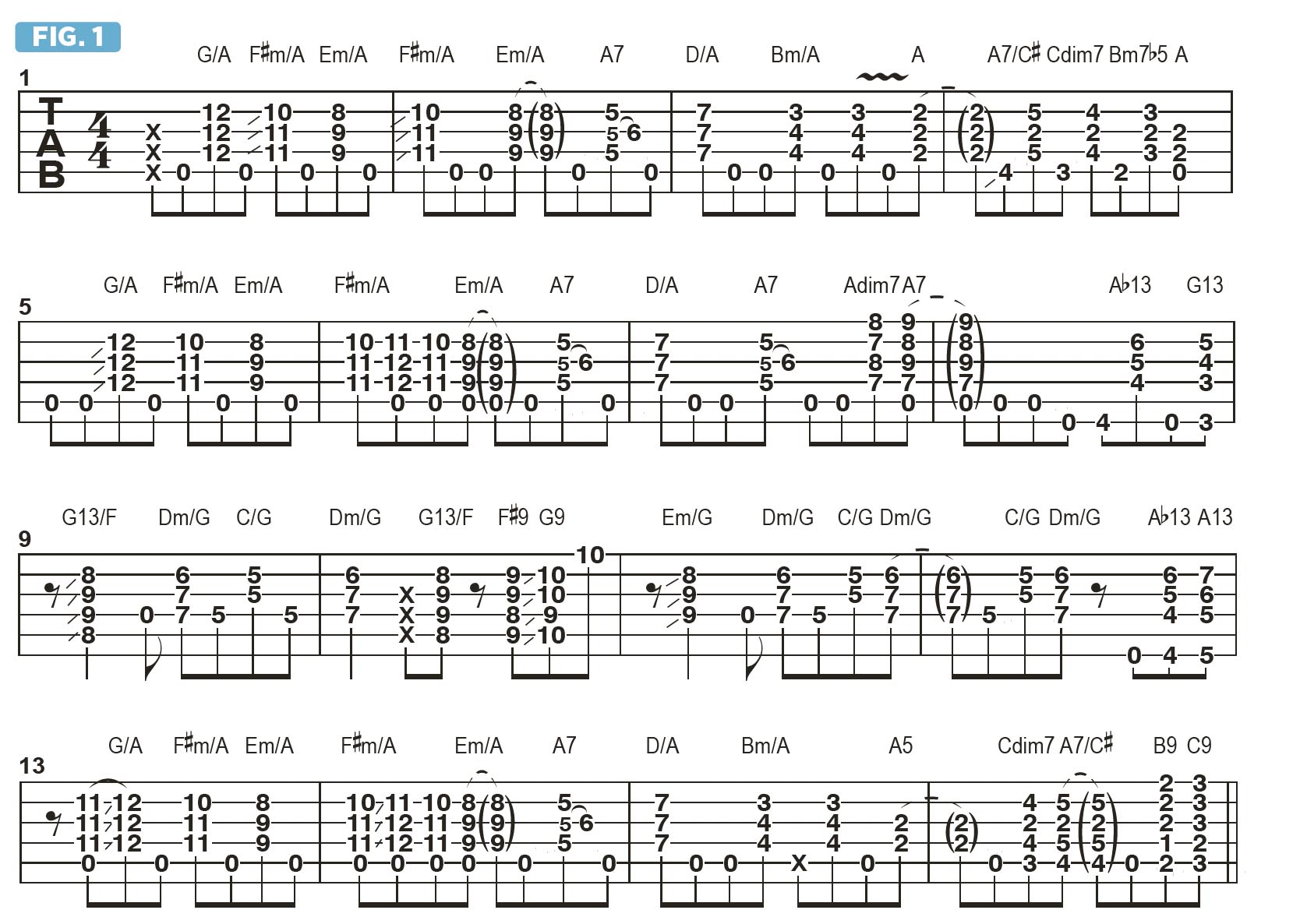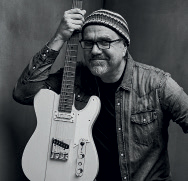An important element in my guitar education was the study of the way jazz and blues organ players comp, or lay down a chord progression while accompanying a soloist, be it themself or someone else.
A great example of this stylistic approach is heard on the tune, 2.65, from my 1994 album Strat’s Got Your Tongue. 2.65 is one of my earliest compositions, and my goal with it was to affect a block-chording/Hammond B3 organ-type sound with a shuffle (eighth-note triplet-based) groove.
The song is constructed from shifting triads played over various open-string pedal tones, and this approach is one that I think can be adopted in a broader way, outside of the scope of the tune itself.
There are two sections of the tune, and Figure 1 represents the main melody, or “A” section. In bars 1-8, I’m harmonizing the A Mixolydian mode (A, B, C#, D, E, F#, G) with a series of triads played on the D, G and B strings while “pumping” an open A-string pedal tone in a manner similar to what you hear B3 organ players do all of the time.

Keyboard players would play a part like this by sounding the descending chord voicings with the right hand while adding the syncopated bass-note accents with the left hand.
Guitar players can approximate this sound by fingerpicking, using the index, middle and ring finger to sound the chords while using the thumb to add the syncopated pedal-tone bass notes. Another option is to hybrid pick the figure, using a flatpick to strike the bass notes and the bare fingers to pluck the chords.
The highest note in each of the moving chord voicings, which are the notes on the B string , can be thought of as the melody, and the lower chord tones on the G and D strings serve to harmonize it below.
The first bar of Figure 2 depicts the A Mixolydian mode played in descending fashion on the B string, and then the next two bars detail each of the three-note triads played in the descending sequence G/A - F#m/A - Em/A - D/A - A7 - Bm/A - A.

Bars 1-3 of Figure 1 illustrate how I used this approach to kick off the “A” section of 2.65. Notice that I’m repeatedly striking the open A-string pedal tone with my thumbed downstrokes in a syncopated rhythm against the moving triads.
I like to add some distinct articulation to each voicing by either sliding up to it from below, adding some vibrato by shaking the strings, or briefly sliding one fret higher and back – the chromatic half-step shift – akin to momentarily bending the pitches of the triad slightly higher.
After stating the melody the first time, I add one of my favorite turnarounds, found in bar 4 of Figure 1 and also depicted more simply in Figure 3. While the A note at the 2nd fret on the G string remains constant among the voicings, the notes on the A, D and B strings move down chromatically to sound the progression A7/C# - Cdim7 -Bm7b5 - A.

After the initial melody is repeated, the progression then modulates down a whole step to G, and similar voicings are played (see Figure 1, bars 9-12), which are based on the G Mixolydian mode (G, A, B, C, D, E, F). Next month, we’ll tackle the tune’s “B” section, which modulates up to C.
Get The Pick Newsletter
All the latest guitar news, interviews, lessons, reviews, deals and more, direct to your inbox!
Greg Koch is a large human who coaxes guitars into submission in a way that has left an indelible print on the psyches of many Earth dwellers. Visit GregKoch.com to check out his recordings, instructional materials, signature musical devices and colorful hats.








![Joe Bonamassa [left] wears a deep blue suit and polka-dotted shirt and plays his green refin Strat; the late Irish blues legend Rory Gallagher [right] screams and inflicts some punishment on his heavily worn number one Stratocaster.](https://cdn.mos.cms.futurecdn.net/cw28h7UBcTVfTLs7p7eiLe.jpg)


